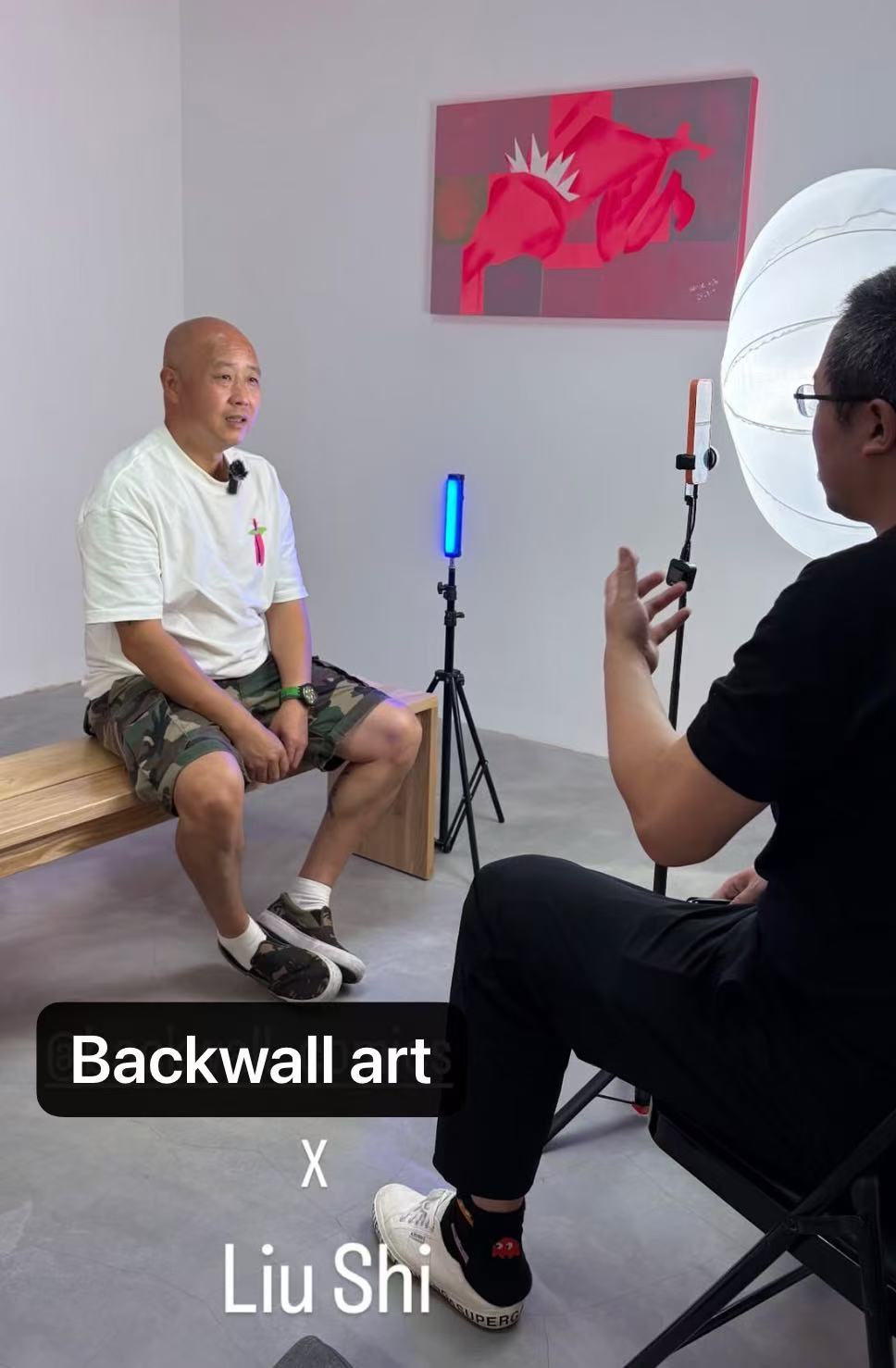Interview & Text by: Tan Xiaozheng (Editor-in-Chief, BACKWALL)
Location: FAUN Gallery, Chengdu
Date: October 14, 2024
On a sunny afternoon in Chengdu, artist Liu Shi sat quietly under the soft light of FAUN Gallery, speaking slowly and calmly about his forty-year journey with painting. There was nothing exaggerated about the way he talked—just like his paintings, his words carried the weight of time: honest, stubborn, and free.
⸻
“At first, I wanted to be a soldier.”
“I actually wanted to join the army when I was a kid,” Liu said with a laugh. “Several of my relatives were soldiers. But because of my father’s political background, that path was closed to me.”
He admitted that as a boy, he didn’t like painting at all. “Back then I thought art was for soft guys. Soldiers with guns—that was real man stuff.”
But his father insisted, guiding him step by step into art. By middle school, Liu had enrolled in Chengdu No. 25 High School, where he met his first real mentor, Li Jixiang, a painter active during China’s ‘85 New Wave’ movement. “That was the first time I truly fell in love with painting,” he said.
⸻
Youth and Idealism: From Sichuan Fine Arts Institute to Abstract Expression
In 1996, Liu entered the Sichuan Fine Arts Institute. It was an era dominated by realism, yet he was drawn to abstract expressionism.
“When some foreign artists came for exchange, it really shook me up,” he recalled. “Out of maybe fifteen classmates, I was the only one painting abstract. I just wanted to do something different.”
But reality hit hard after graduation. “I thought I’d serve the country after college,” he said, “but I couldn’t even pay my rent.”
He worked part-time at a business college in Chengdu, earning 180 yuan a month, saving every bit to buy paint. “Those were the years when ideals collided head-on with reality.”
⸻
The Blue Roof Years: Freedom and Loss
By 2004, Liu had joined Blue Roof Art District, a legendary place for Sichuan’s contemporary artists. “Everyone was broke but pure,” he laughed. “We painted, debated, and drank together every day.”
Then disaster struck. After the 2008 Wenchuan earthquake, floods in 2009–2010 destroyed nearly 70% of his work. “That day, I went crazy,” he said. “I even posted on Weibo: ‘God asked me if I’d lost my mind.’ I didn’t paint for half a year after that.”
The loss became a turning point. “I started questioning everything—what is art, really? Is it worth betting my whole life on it?”
⸻
Refusing Representation: Staying Wild and Independent
“In 2006, a Beijing gallery offered to represent me,” he said, “but they wanted me to make things that would sell. I turned them down.”
His tone stayed calm but firm. “Art shouldn’t be controlled by sales logic.”
Since then, Liu has handled most of his own shows. “I once saw FAUN Gallery’s account on WeChat, left a message: ‘Would you like to collaborate?’ They replied the next day, we added each other on WeChat, and three days later the show was set.”
“I don’t think self-recommending is embarrassing,” he added. “It’s confidence. Western artists do it all the time—why can’t we? Putting yourself out there honestly is a kind of strength.”
⸻
The Art Scene and Its “Rivers and Lakes”
When asked about the Chengdu art world, Liu smiled slightly. “Anywhere there are people, there’s jianghu—the rivers and lakes,” he said, referring to the Chinese word for social undercurrents and hidden politics.
“I realized a lot of relationships were just surface-level. So I became more independent, stopped hanging around the scene.”
He still respects Blue Roof for what it gave him, but he added, “Now I’d rather be one of the old Blue Roof guys—unaffiliated, unclassified.”
⸻
“Not a Contemporary Artist”—Just an Artist
“I’ve never labeled myself a ‘contemporary artist,’” Liu said. “I’m just an artist. Since I was a kid, maybe I was destined to live for art.”
His paintings often feature soldiers, wars, and tension—echoes of his childhood dream. “I’m not painting violence,” he explained. “I’m painting power. Honesty in conflict.”
⸻
Epilogue: Painting as Faith
As the interview wrapped up, Liu spoke softly:
“Painting, to me, is a form of faith. I don’t live off it—I live through it.”
From a boy who dreamed of the army to an artist who insists on freedom; from canvases ruined by floods to the courage to knock on new doors—Liu Shi’s story, like his paintings, doesn’t please or explain. It simply stays true to itself.
⸻
🎨 Postscript
At FAUN Gallery, Liu’s latest works radiate a strange duality—both violent and tender. That tension is his true color, forged over time. In a noisy, distracted world, he remains proof that an artist can stay awake and burn bright.
